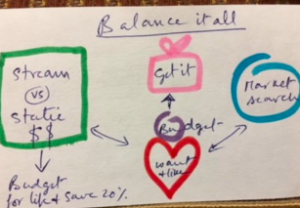“Holiday Shopping with Champagne Taste…. and beer pocket money!” – a wise mom reports to me recollecting her family adage of intergenerational reprimand in shaping the children’s indulgence. One fascinating thing I recognize with Champagne taste is if you are very talented in searching for the best in terms of quality and sophistication with artful and analytical mind, you are often falling into the trap of finding that at some high cost, more often than not. It is easy to justify it as a child or teen who has no major responsibilities and tunnel vision of how rich they are with the birthday money, rewards or wages they accumulated.
I like to draw this diagram for teens who think they have “huge stash of $$” (cf. insert) to explain how it works in simple terms. I would encourage them to think of static funds coupled with the stream of funds contributing to the quasi sum, the driving force of wanting and liking (driven primarily by their amygdala and nucleus accumbens working closely*) in sync with the matching budget to spend, market search within that budget to finally arrive at the holiday present. In this rarefied world, it is not bad to factor in the world’s needs at large, i.e., save 20% of their stash and give some. That by the way, reminds me of our 18 year old son who purchases groceries and prepares sandwiches to the homeless on the Michigan Avenue each week, sometimes several times a week now that he is on his holiday break from College. I thought it was awesome to see this till my husband pointed out that it really is better if he earns and makes sandwiches with his earnings. So, we are talking charity ground up (Is that stretching too much?).
That aside, let me not be an old fashioned Grinch. It is fun to buy, recieve and enjoy presents. Why not! But measured, thoughtful pep talk might temper high expectations from Secret Santa, YOU.
PS. Blame me if/when your children are frustrated if/when you share this paradigm with them.
* Pavuluri M, Volpe K, Yuen A. Nucleus Accumbens and Its Role in Reward and Emotional Circuitry. AIMS Neuroscience, 2017, 4(1): 52-70. doi: 3934















